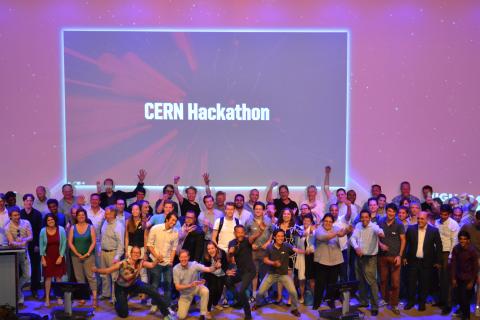A reverse hackathon with CERN

What if we selected a few CERN Technologies and put them in the hands of professionals that help create highly successful start-ups?
Six high-tech business teams were selected to explore business solutions for CERN technologies within the HighTechXL Accelerator Program. They presented their winning projects during the CERN Hackathon in the Netherlands, organised jointly by CERN, Nikhef, and HighTechXL. The teams will now go on to explore technologies connected to novel lasers, accelerator technology, and cooling systems and their applications to industrial applications for satellite communication, medical technology and high stability cooling.
They will spend the next three months at the HighTech Campus in the Netherlands, an accelerator programme designed exclusively for advanced-technology and hardware entrepreneurs, and part of the Eindhoven Brainport Ecosystem. “The Brainport region and its density of ultra-high-tech companies, such as Philips and ASML, is the obvious place to bring together innovators and CERN technology. We have selected technologies that fit well with this ecosystem to have as much synergy as possible,” said Dr. Jan Visser, industrial liaison officer for CERN from Nikhef.
The CERN Hackathon was centred on promising CERN technologies and sought to recruit highly motivated teams capable of imagining relevant commercial applications for them. The process challenged the usual start-up accelerator approach, which is generally focused on a customer or solution. With this initiative, CERN and Nikhef hope to tap into this high tech community by providing leading technologies backed by CERN’s research prestige to find new applications. HighTechXL uses its network to attract participants with the relevant technical affinity and business acumen. “This collaboration provides a unique opportunity for high-tech industry experts to become founding members of new fast-growing high-tech companies,” said HighTechXL founder Guus Frericks.
The CERN, Nikhef, HighTechXL collaboration kicked off on July 2 with 100 participants, the best from the pool of candidates. CERN has been working for several years to develop a culture of entrepreneurship, either by bringing its technology to entrepreneurs, or by bringing entrepreneurs to CERN. This entrepreneurship ecosystem is developed through programmes such as the CERN Entrepreneurship Meet-Ups (EM-Us), the CERN Entrepreneurship Student Programme (CESP), and through CERN’s network of Business Incubation Centres (BICs), which exist in ten of CERN’s Member States. Since early 2018, CERN and Nikhef have been revitalising the Dutch BIC by looking for new ways to explore the significant potential of certain CERN’s technologies and decided to collaborate with HighTechXL, whose purpose is to create and support start-ups around state-of-the-art technology.
“CERN technologies are complex and state-of-the art, and they could have revolutionary potential. One has to go very deep to understand, yet the reward can be significant,” says Han Dols, working at the CERN Knowledge Transfer Group. “The motivation and commitment of the teams is impressive, especially knowing some are, at this stage, participating on top of their daily jobs. Clearly they recognize this programme as a unique chance to build a business from these beautiful CERN technologies.”
The technologies that will be further explored in the HighTechXL Accelerator Program are: evaporative cooling using carbon dioxide (CO2), long-distance structured laser beam (SLB), and a novel compact high frequency radio-frequency quadrupole (HF-RFQ) linear particle accelerator. These technologies served as inspiration for the winning teams High Tech Cooling, Microspot, Modular Energies, Dynaxion and Dynaxion 2. Participation in the programme gives them access to an array of experts in law, funding, design, communication, and business. “The knowledge we have in the BIC Network about start-ups, creating effective teams, financing, etc., as well as the broad network of collaborators and mentors at our disposal, tell us that these teams should be able to convert their ideas into realistic business opportunities,” explains Dr. Visser. At the end of the programme, they will pitch to an investor audience made up of large companies from the Eindhoven ecosystem and venture capitalists.
What sort of solutions can come from CERN’s tech?
To cite only some of the proposed solutions, High Tech Cooling plans to tap into evaporative cooling using carbon dioxide (CO2) to control the temperature of high-tech devices to very high stabilities with minimal variety over the object to be cooled. This technology can use very small pipes enabling new applications, and can be supplied from a long distance. In addition, it has a much lower negative impact on the environment, as it uses CO2 instead of fluorocarbon refrigerants.
Modular Energies addresses the difficult access to radioisotopes - for example, in smaller or more remote hospitals - to improve access to certain types of diagnostics. By using the modest size of the compact high frequency radio-frequency quadrupole (HF-RFQ) linear particle accelerator, Modular Energies plans to enable hospitals with access to radioisotopes through the low cost of ownership, high uptime, ease of use, short installation time, low weight, high radiation safety, compact size, and even installation in existing housing. Currently, the team is looking for high tech equipment developers, an applied physicist who can start the testing phase and enjoys doing simulations, and for someone with a business background.
Microspot, as a final example of these technological applications, addresses the increasing demand for data processing capacity and proposes the solution might be satellite communication. The team projects to use a long-distance structured laser beam (SLB) for inter-satellite communication, using the fact that laser beams are characterized by little divergence over long distances, and proposing the SLB might deliver a faster, more secure, lighter, and cheaper way for data transmission between satellites compared to current solutions. Currently, the team is looking for people with technical backgrounds to work full- or part-time, preferably from a telecommunications and/or satellite systems background.
Article originally published in Accelerating News.
- Log in to post comments
